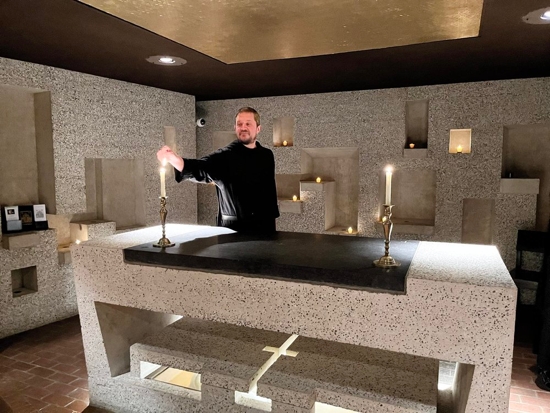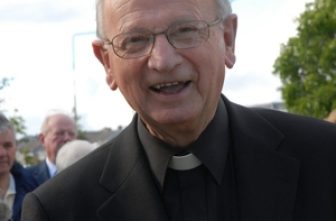
While Minnesota may be relatively new on the scale of Church history, it does hold the remains of one of the Church’s first saints.
In the reliquary underneath St. John’s Abbey and University Church in Collegeville is a tomb containing the bones of St. Peregrine, an early Christian martyr. The Shrine of St. Peregrine is a window into the early Church and a special place of grace in the state.
St. Peregrine, martyr — not to be confused with St. Peregrine Laziosi, the patron saint of cancer patients — lived in Rome in the second century. One day in the year 192, the Emperor Commodus dressed himself in a leopard skin, paraded down the streets of Rome, and demanded that the people worship him as the god Hercules. St. Peregrine, just a boy, was troubled by this. He and three young men — Eusebius, Vincent and Pontian — took to the streets to proclaim Christ and denounce the emperor’s blasphemy. Their message was this: “Give honor to the one God; the Blessed Trinity; the omnipotent Father, the Son and the Holy Ghost. Do penance and be baptized, lest you perish together with Commodus,” according to an account of their martyrdom found at SaintJohnsAbbey.org/peregrine on the abbey’s website.
Their preaching inspired the Roman senator Julius to convert. He began speaking about Christ and giving of his wealth to the poor. When Emperor Commodus heard of this, he commanded Julius to worship him. Julius refused and was put to death. Emperor Commodus later had St. Peregrine and his companions tortured. They remained faithful. According to accounts of their martyrdom, an angel appeared to protect them, causing one of the torturers to flee and be baptized. After they had endured great suffering, the emperor gave the youths one final chance to renounce their faith in Christ. They refused and were put to death.
The body of St. Peregrine remained in Rome for over 1,500 years before making a very roundabout journey to Minnesota.
In 1731, Benedictine Abbot Kilian Kneuer brought the relics of St. Peregrine and St. Aurelian to his monastery in Neustadt am Main, Germany. Their side altars became popular places of veneration in the abbey church. The church burned in 1854, but the relics of the two saints were saved. In 1895, Benedictine Father Gerard Spielmann of St. John’s Abbey in Minnesota took a trip to his homeland in Germany. While there, he requested the relics from the prince of Loewenstein-Wertheim, the owner of the monastery properties at the time. The prince agreed on the condition that St. Peregrine always be kept by Benedictines. Father Gerard brought the relics across the Atlantic to his parish, St. Anselm in New York City. They remained there until 1927, when St. John’s Abbot Alcuin Deutsch requested that they be transferred to St. John’s Abbey.
Today, the Shrine of St. Peregrine is open to the public daily from 6 a.m. to 10 p.m. To access the crypt, visitors can enter the abbey church through the main entrance and walk down the steps to the left and right of the baptismal font. St. Peregrine is buried underneath the shrine’s altar and his bones are visible through openings in the stone tomb. The underground shrine, built for him, also contains many other smaller relics. During the Easter season, there is a tradition of visiting the shrine to pray to St. Peregrine for the vocations of young people. The abbey venerates him on the fourth Sunday of Easter every year.
The Shrine of St. Peregrine reminds those in the Church’s newest frontiers — like Minnesota — that the saints are not merely stories from faraway lands. They were real people who, in a wide array of different circumstances, devoted their lives to Jesus.
“It really shows the universality of the Church and serves as a reminder of the universal call of holiness,” said Peter Brown, a recent master’s degree graduate of St. John’s University and the incoming music director of St. Joseph in West St. Paul.





Supporting God’s gift of life